A Project of the Hudson River Estuary Program
Compiled and edited by Tom Lake, Consulting Naturalist
Love Our NY Lands
State Lands Belong to All of Us
All New Yorkers and visitors should be able to access, enjoy, and feel welcome on state lands. These lands belong to all of us, our families, and our neighbors. While enjoying these shared spaces, be respectful of other visitors. Share trails, treat people with kindness, and leave things as you found them for others to enjoy. All of us have a responsibility to protect State lands for future generations. For more information, visit DEC's website.
Overview
There were signs of autumn everyone this week, from fall colors to woolly bears to squadrons of great blue herons heading south. The river was holding its warmth, but salinity beginning to ebb from heavy rains up in the watershed. We also took a journey back to an amazing autumn discovery 23 years ago.
Highlight of the Week
 10/2 – Croton River, HRM 34: A favorite part of autumn bird migration for me is the annual showing of great blue herons in the marshes and on the tide flats. If memory serves, my previous high count was 22 birds, a spectacular assemblage. 10/2 – Croton River, HRM 34: A favorite part of autumn bird migration for me is the annual showing of great blue herons in the marshes and on the tide flats. If memory serves, my previous high count was 22 birds, a spectacular assemblage.
Today, I counted 42 at low tide — counted them twice more just to be sure the count was good — in the marsh, on the flats, and down into Inbuckie. I reported the sighting to John Phillips, curator at the Croton Point Nature Center and had my balloon partially deflated: the day before, several observers had counted 52 great blue herons. (Photo of great blue heron courtesy of Deborah Tracy Kral)
- Christopher Letts
[Inbuckie and Crawbuckie are colloquial names used to describe the mile of tidemarsh and shoreline between the mouth of the Croton River and Ossining (river miles 34-33). The origin of the names is hazy, but they have been commonly used by local Rivermen for well over a century. Crawbuckie is the low-tide beach on Croton Bay made equally famous in the 1960s and 70s by striped bass anglers, when catching one of any size was big news. Inbuckie is the adjacent tidemarsh inside, east of the railroad tracks. Prior to the early nineteenth century when the railroad bisected them, they were one. Tom Lake]
Natural History Entries
 9/22 – Hyde Park, HRM 82: On this date in 1999 (23 years ago), our SUNY Dutchess Community College Behavioral Sciences department received a phone call from a homeowner asking for help in identifying two huge bones that were discovered in his yard in Hyde Park along Fallkill Creek, a Hudson River tributary (somehow, our department was the closest he could find to paleontology). 9/22 – Hyde Park, HRM 82: On this date in 1999 (23 years ago), our SUNY Dutchess Community College Behavioral Sciences department received a phone call from a homeowner asking for help in identifying two huge bones that were discovered in his yard in Hyde Park along Fallkill Creek, a Hudson River tributary (somehow, our department was the closest he could find to paleontology).
This was a serendipitous discovery by the landowner. He was deepening a former glacial kettle pond, now a backyard pond, the size of a hockey rink, with an excavator when the bones came up in the shovel. Bob Schmidt identified them as a humerus, and an ulna. What followed was a 13-month adventure wrapped around a mystery. Were these the bones of a large extinct mammal from the Hudson River Valley's deep past? Or had an elephant run away from the circus and drown in the pond?
The answer took thirteen months to uncover and the journey we took touched many hundreds of students and professionals creating a lifetime of memories. Dave Strayer analyzed an assemblage of mollusks found at the bottom of the pond and dated them to 12,000 year ago, the Late Pleistocene. This community of mollusks exists today in Hudson Bay, 1,200 miles north.
Using ground-penetrating radar, Cornell University paleontologists found the “bone bed.” The nearly complete skeleton of a mastodon, in life ten-feet-high and ten-thousand pounds, was excavated out of an ancient oxbow of the ancestral Fallkill Creek. One of the tusks was radiocarbon dated to 11,480 years ago, and the skeleton, 98% complete, now resides at the Paleontological Research Institution in Ithaca, the site’s principal investigator.
On September 30, 2000, we closed the Hyde Park mastodon site after 392 days. Our last act was to toss a shiny 2000 Lincoln penny into the excavation as a marker for any future scientists. (Photo of mastodon with permission by New York State Museum)
- Tom Lake, John Chiment
[The Hyde Park mastodont is an extinct form of “elephant” (taxonomic order Proboscidea) that roamed the Hudson Valley in the Late Pleistocene about the time that the first people arrived, and the Hudson River was becoming an estuary. The American mastodont (Mammut americanum) was part of a faunal community, many of which are now extirpated or extinct, that included American elk, ground sloth, woodland caribou, giant beaver, horse, flat-headed peccary, and stag-moose. The Discovery Channel produced a television documentary of this excavation called Mastodon in Your Backyard: The Ultimate Guide which first aired on October 7, 2001. Tom Lake]
[To be, or not to be ...
Extant means populations that are still found in a specific area, such as black bears and bobcats. Extirpated means a species that is no longer found in a specific area but does exist elsewhere, for example the gray wolf and mountain lion. Extinct means they no longer exist, gone forever, like the American mastodon, woolly mammoth, and the passenger pigeon. Tom Lake]
 10/1 – Little Stony Point Preserve, HRM 55: Dawn came with heavy overcast; it was not much more just a slight brightening of the air. A stiff north wind quartered the deserted beach as a steady rain fell (the fringe of former hurricane Ian). The river was 69 degrees Fahrenheit (F), 20 degrees higher than the air. It felt like a warm blanket on our legs. 10/1 – Little Stony Point Preserve, HRM 55: Dawn came with heavy overcast; it was not much more just a slight brightening of the air. A stiff north wind quartered the deserted beach as a steady rain fell (the fringe of former hurricane Ian). The river was 69 degrees Fahrenheit (F), 20 degrees higher than the air. It felt like a warm blanket on our legs.
We hauled our seine into the current and caught only young-of-year striped bass (50-79 millimeters); we hauled against the current and caught only Atlantic silverside (74-76 mm) — the mysterious vagaries of tidewater. The only other life in the net were two male softshell blue crabs (40 mm). The salinity had dropped to 2.5 parts-per-thousand (ppt). (Photo of blue crab courtesy of T.R. Jackson)
- Tom Lake, A. Danforth
[As a crustacean, blue crabs have an exoskeleton (their skeleton is on the outside) and they must moult their hard shell periodically as they grow to accommodate their increasing internal body size. Their new soft shell is somewhat larger and has the elasticity of a balloon. They take in water to stretch the new shell, and once the shell hardens — a process that can take up to twenty-four-hours depending on water temperature — they expel the water creating roomier accommodations. While they are in a softshell stage, they are completely vulnerable to predation as they are unable to use their tearing and crushing claws.
I took one softshell to the lab to see how long “hardening” would take. Since it was already softshell when caught, the elapsed time would be approximate. In the end it, took him an additional eleven hours to regain the use of his claws and prepare to rip off my fingernails. Tom Lake]
[The standard research measurement for blue crabs (mm) is point-to-point, laterally, across their carapace.]
10/1 – Bedford, HRM 35: Of the 70 south-migrating raptors today at the Bedford Audubon Chestnut Ridge Hawkwatch, sharp-shinned hawk was high count with 35. Cooper's hawk (15) also showed well. We noted seven turkey vultures that we called migrant. Non-raptor migrants included 159 blue jays, 63 cedar waxwings, and 15 American robins.
- Richard Aracil, Adam Bradley
*** Fish of the Week ***
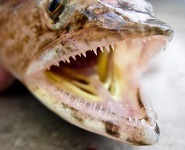 10/2 – Hudson River Watershed: Fish-of-the-Week for Week 190 is the inshore lizardfish (Synodus foetens) number 102 (of 236) on our watershed list of fishes. If you would like a copy of our list, e-mail trlake7@aol.com. 10/2 – Hudson River Watershed: Fish-of-the-Week for Week 190 is the inshore lizardfish (Synodus foetens) number 102 (of 236) on our watershed list of fishes. If you would like a copy of our list, e-mail trlake7@aol.com.
The inshore lizardfish is the only member of its family (Synodontidae) in the watershed. They favor inshore marine waters of the Atlantic from Cape Cod to Brazil. Inshore lizardfish lurk in sandy shallows, burrowing in the bottom sediments to ambush passing prey. The common name of their close relative, the sand diver (S. intermedius), found from the Carolinas to points south, describes the behavior of the genus.
Inshore lizardfish are terete (cylindrical) in cross-section and have been likened to a colorful cigar. While only reaching 18 inches, they have the countenance of an apex predator with tooth-studded jaws and a reptilian look. At various times in the long ichthyological past, because of their tiny adipose fin and impressive teeth, taxonomists have placed lizardfish in with the trouts (Salmo sp.) and pikes (Esox sp.).
Years ago, as I was snorkeling along the sandy beach at Croton Point, I drifted over a foot-long inshore lizardfish, stock-still, propped on its pelvic fins, mouth slightly agape, and looking like a dragon in wait.
The inshore lizardfish is a temperate marine stray in the estuary. Young-of-year are carried into the brackish waters of the Hudson River on summer flood tides and are found as far upriver as Croton Point (river mile 35).
- Tom Lake
10/2 – Bedford, HRM 35: Of the 111 south-migrating raptors today at the Bedford Audubon Chestnut Ridge Hawkwatch, sharp-shinned hawk was high count with 52. Cooper's hawk (25) also showed well. We saw decent movement on this gray, blustery day with a definite jump in turkey vulture migration (30).
Non-raptor migrants included 260 Canada geese, 13 cedar waxwings, 131 blue jays, 63 American robins, 30 double-crested cormorants, and 10 green-winged teal.
- Richard Aracil, Adam Bradley, Karen Troche, Pedro Troche
10/3 – Bedford, HRM 35: Among the 186 south-migrating raptors today at the Bedford Audubon Chestnut Ridge Hawkwatch, sharp-shinned hawk was high count with 117. Cooper's hawk (26) and American kestrel (22) showed well. We also saw a big movement of turkey vultures (83). Non-raptor migrants included 208 Canada geese, 7 cedar waxwings, 126 blue jays, 327 American robins, and 7 common loons.
- Richard Aracil, Adam Bradley
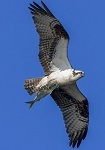 10/3 – Croton Point, HRM 35: In a midday low tide, we set our 30-foot seine in the little cove we call Mother’s Lap preparing for Coman Hills Elementary students from Armonk. Despite a raw and windy day, they were excited. The students quickly found two “sheds,” moulted blue crab exoskeletons on the beach, as well as the leftovers of an “eagle meal,” a partially-eaten Atlantic menhaden. 10/3 – Croton Point, HRM 35: In a midday low tide, we set our 30-foot seine in the little cove we call Mother’s Lap preparing for Coman Hills Elementary students from Armonk. Despite a raw and windy day, they were excited. The students quickly found two “sheds,” moulted blue crab exoskeletons on the beach, as well as the leftovers of an “eagle meal,” a partially-eaten Atlantic menhaden.
We made a haul in the stiff chop and the seine came in with many small fish flashing and splashing in the net. When the decibel level slackened, we discovered that we had caught young-of-year striped bass and Atlantic silverside, banded killifish of all sizes, and a small palm-sized blue crab hiding in the folds of the seine. Overhead we spotted a riveting sky show including an immature bald eagle as well as almost non-stop osprey traffic, some carrying fish. (Photo of osprey courtesy of Deborah Tracy Kral)
- Christopher Letts, John Phillips
10/4 – Bedford, HRM 35: In a constant mist and drizzle, we counted just two south-migrating raptors today at the Bedford Audubon Chestnut Ridge Hawkwatch. Both were sharp-shinned hawks. Non-raptor migrants included 46 blue jays and 28 American robins.
- Richard Aracil
10/4– Yonkers, HRM 18: Our staff at the Sarah Lawrence Center for the Urban River at Beczak made our five seine hauls today at low tide. Nevertheless, the water level was much higher than usual for a low tide, closer to our mid-tide levels. I’m guessing this was due to the remnant effects of former Hurricane Ian.
Assessing our catch, we found that Leidy’s comb jellies, quite surprising, were high count with 34. Among fishes we found Atlantic silverside (8), bay anchovies (3), and one white perch. The water temperature had fallen nine degrees in six days to 61 degrees F, salinity was 13.0 ppt, and the dissolved oxygen was 7.7 parts-per-million (ppm).
- Jason Muller, Rachel Lynch
10/5 – Bedford, HRM 35: Of the 92 south-migrating raptors today at the Bedford Audubon Chestnut Ridge Hawkwatch, sharp-shinned hawk was high count with 75. The reliable migration of turkey vultures (11) continued. Non-raptor migrants included 816 blue jays and 421 American robins.
- Richard Aracil, Adam Bradley
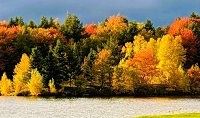 10/6 – Greene County: Over the last week of September, at least three evening rainbows were seen from my home in the Catskills — one was a double arch. Another mid-afternoon and less common circum-zenithal rainbow appeared as a “smiling” arc formation directly overhead along with two rainbow “sundogs” above the western horizon. I always marvel at the exquisite beauty of these refraction phenomenon. 10/6 – Greene County: Over the last week of September, at least three evening rainbows were seen from my home in the Catskills — one was a double arch. Another mid-afternoon and less common circum-zenithal rainbow appeared as a “smiling” arc formation directly overhead along with two rainbow “sundogs” above the western horizon. I always marvel at the exquisite beauty of these refraction phenomenon.
This week with October here the autumnal colors were peaking in the Catskills with still a lot of green shades but many vibrant red, orange, and gold accents. Fall is the season that outdoes itself with beauty, as if to say “remember.” Soon the trees and the mountains will turn grey and then white for the next five months. (Photo of fall colors courtesy of Mario Meier)
- Mario Meier
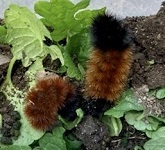 10/6 – Town of Wappinger, HRM 67: On a nice Indian Summer Day we found two banded woolly bear caterpillar inching-along through the last green grass of the season. The woolly bear is the larval form of the Isabella tiger moth (Pyrrharctia isabella). 10/6 – Town of Wappinger, HRM 67: On a nice Indian Summer Day we found two banded woolly bear caterpillar inching-along through the last green grass of the season. The woolly bear is the larval form of the Isabella tiger moth (Pyrrharctia isabella).
Our two woolly bears were dominated by their middle brown bands, 22 mm for the first, flanked by two lesser black bands (9, 10), and 19 mm for second caterpillar, flanked, by two lesser black bands (9, 4). Individually, the brown sections were 54 and 59 percent of their total lengths.
We thought of the old, but perhaps not entirely discredited, folklorist belief that the wider the middle rusty-brown section, as a percentage of their total length, the milder the coming winter will be. Conversely, the wider the combined black sections the more severe the winter will be. (Photo of wooly bear courtesy of Phyllis Lake)
- Tom Lake, Phyllis Lake
[Is there science involved in reading the woolly bear’s bands? Beginning in 1948, Dr. C. H. Curran, curator of insects at the American Museum of Natural History, conducted wooly bear caterpillar research each autumn at New York’s Bear Mountain State Park. Dr. Park’s data suggests that the combination of wide and narrow bands, as a percentage of their total length, can predict the severity of the winter to come. If we were inclined to believe, we would expect a somewhat milder winter this year. Tom Lake]
10/6 – Little Stony Point Preserve, HRM 55: It was a great day to be on the beach; with the air temperature in the mid-70s, the river at 67 degrees F felt a bit chilly. Despite recent heavy rains, we were surprised to find the salinity had risen a little to 3.0 ppt. When rain hits the upper areas of the watershed, it takes time for effects (drainage) to reach the Hudson Highlands.
With autumn marching on, we were hoping to catch some last-minute marine fishes heading back to the sea, but none showed. We were content with young-of-year striped bass (67-89 mm) and Atlantic silverside (66-74 mm). There was one surprise, a handful of Beroe’s comb jellies looking like little translucent pearls in the seine.
- Tom Lake, Phyllis Lake
[Comb jellies (Phylum Ctenophora) are often mistaken for jellyfish but differ in that they have no tentacles and do not sting. Like true jellyfish, comb jellies are translucent, gelatinous, fragile, essentially planktonic, drifting at the whim of the wind and current. They are peanut to walnut-sized, often occur in swarms, and are common in warm, brackish estuarine shallows. For a real treat, gently scoop a few from a net with a wet, cupped hand, place them into a small clear container, and gently rock the water. Their rhythmic, symmetrical, and altogether graceful movements are enchanting. We have two common species in Hudson River tidewater, Beroe's comb jelly (Beroe cucumis) and Leidy’s comb jelly (Mnemiopsis leidyi). Tom Lake]
 10/6 – Bedford, HRM 35: Of the 346 south-migrating raptors today at the Bedford Audubon Chestnut Ridge Hawkwatch, sharp-shinned hawk was high count with 277. It was a big day for sharp-shinned hawks as we broke our previous one-day record of 266 set just last month. We counted our first black vultures (4) of the season. Cooper’s hawk (26) also showed well. 10/6 – Bedford, HRM 35: Of the 346 south-migrating raptors today at the Bedford Audubon Chestnut Ridge Hawkwatch, sharp-shinned hawk was high count with 277. It was a big day for sharp-shinned hawks as we broke our previous one-day record of 266 set just last month. We counted our first black vultures (4) of the season. Cooper’s hawk (26) also showed well.
Non-raptor migrants included 5 monarch butterflies, 333 blue jays, 54 American robins, and 5 chimney swifts, 3 common nighthawks, and 64 Canada geese. (Photo of black vulture courtesy of Ann Brockelman)
- Richard Aracil, Adam Bradley
10/6 – Hook Mountain, HRM 31: Among 50 south-migrating raptors today at the Hook Mountain Hawkwatch, sharp-shinned hawk was high count with 37. Migrants were mostly low and easy to see perhaps attracted by the presence of passerines around the summit all day.
This was an unusually active day on the Hook, with insect and bird activity all day. Among the insects were many marmorated stink bugs, a monarch butterfly, and one spotted lanternfly. Among the birds were five woodpecker species: downy woodpecker, hairy woodpecker, red-bellied woodpecker, northern flicker, and yellow-bellied sapsucker.
- Trudy Battaly, Drew Panko, Avril Armstrong, Raimund Miller
10/6– Yonkers, HRM 18: Our staff at the Sarah Lawrence Center for the Urban River at Beczak hosted a 4th grade class from the Trinity School in Manhattan. With the students assisting, we made eleven hauls of our seine. It was a big day for invertebrates led by a high count of 355 Leidy’s comb jellies. Blue crabs (33) also showed well. Among the fishes, we found Atlantic silverside, American eel, and young of year striped bass. The water temperature was 62 degrees F, salinity was 13.0 ppt, and the dissolved oxygen was 7.6 ppm.
- Jason Muller, Christina Edsall, Katie Lamboy, Ishika Joshi –
10/7 – Green Island, HRM 153.4: At sunup, the head of tide was in the last of the ebb, and nearly 100 Canada geese (extrapolated) were jammed in a backwater off the main channel below the Federal Dam. They may have set down for the night (last night) but they did not look eager to leave. Geese are well-known as night-flyers, but they also take many respites in migration. The geese were a nice find, but the bonus for my visit occurred at either end of the parking lot, where I came upon colorful male purple finches. Roger Tory Peterson eloquently described them best as “looking like a sparrow dipped in raspberry juice.”
- Tom Lake
[The purple finches have arrived. They are often mistaken for the common year-round house finch. However, purple finches are a bit larger with more distinctive facial markings. Rich Guthrie]
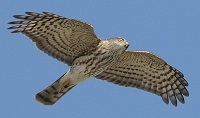 10/7 – Bedford, HRM 35: We counted 214 south-migrating raptors today at the Bedford Audubon Chestnut Ridge Hawkwatch; sharp-shinned hawk was high count with 163.Turkey vulture (67) showed well, our best day so far. 10/7 – Bedford, HRM 35: We counted 214 south-migrating raptors today at the Bedford Audubon Chestnut Ridge Hawkwatch; sharp-shinned hawk was high count with 163.Turkey vulture (67) showed well, our best day so far.
Non-raptor migrants included 5 monarch butterflies, 119 tree swallows, 31 chimney swifts, 14 purple finches, 18 American robins, 34 cedar waxwings, and 11 common nighthawks, a nice surprise. (Photo of sharp-shinned hawk with permission by Connecticut Audubon)
- Richard Aracil, Sadie Dyer, Tom Burns
 10/7 – Hook Mountain, HRM 31: Among 45 south-migrating raptors today at the Hook Mountain Hawkwatch, sharp-shinned hawk was high count with 20. There were a lot of spotted lanternflies and even more brown marmorated stink bugs. (Photo of brown marmorated stink bug courtesy of Tom Myers) 10/7 – Hook Mountain, HRM 31: Among 45 south-migrating raptors today at the Hook Mountain Hawkwatch, sharp-shinned hawk was high count with 20. There were a lot of spotted lanternflies and even more brown marmorated stink bugs. (Photo of brown marmorated stink bug courtesy of Tom Myers)
- Raimund Miller
10/7– Yonkers, HRM 18: This was Day 2 of a visit from the 4th grade classes at the Trinity School in Manhattan. With the students helping, our staff at the Sarah Lawrence Center for the Urban River at Beczak made eleven hauls of our seine. Leidy’s comb jellies were again high count with 66. Crustaceans included blue crab (41) and grass shrimp (12). Fishes were few, with only American eel, bay anchovy and Atlantic silverside.
The water temperature was 63 degrees F, salinity was 13.5 ppt, and the dissolved oxygen was 7.0 ppm.
- Christina Edsall, Katie Lamboy, Jason Muller, Kinza Siddiqui
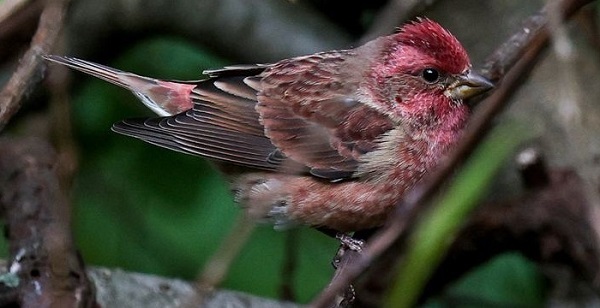
Fall 2022 Natural History Programs and Events
Come Canoeing with the National Estuarine Research Reserve
Free public canoe program in the tidal marshes of the Hudson River estuary. Learn about the wildlife and dynamic system of the tidal wetlands. Information and registration link:
https://2022-nysdec-canoeprogram.eventbrite.com
November 17, 7:00 p.m. The River Before Henry: First Nations Last Elephants
Glens Falls- Saratoga Chapter of the Adirondack Mountain Club
Saratoga Public Library, Saratoga Springs
Tom Lake (DEC Hudson River Estuary Program)
Hudson River Education
Teachers and students will enjoy our new Hudson River K-12 Unit of Study. This carefully curated group of lesson plans, arranged by topic and/or grade, brings together great learning tools developed by the DEC and dozens of estuary partners.
Hudson River Miles
The Hudson is measured north from Hudson River Mile 0 at the Battery at the southern tip of Manhattan. The George Washington Bridge is at HRM 12, the Tappan Zee 28, Bear Mountain 47, Beacon-Newburgh 62, Mid-Hudson 75, Kingston-Rhinecliff 95, Rip Van Winkle 114, and the Federal Dam at Troy, the head of tidewater, at 153. The tidal section of the Hudson constitutes a bit less than half the total distance – 315 miles – from Lake Tear of the Clouds to the Battery. Entries from points east and west in the watershed reference the corresponding river mile on the mainstem.
To Contribute Your Observations or to Subscribe
The Hudson River Almanac is compiled and edited by Tom Lake and emailed weekly by DEC's Hudson River Estuary Program. Share your observations by e-mailing them to trlake7@aol.com. To subscribe to the Almanac (or to unsubscribe), use the links on DEC's Hudson River Almanac or DEC Delivers web pages.
Useful Links
National Oceanic and Atmospheric Administration online tide and tidal current predictions are invaluable when planning Hudson River field trips. For real-time information on Hudson River tides, weather, and water conditions from sixteen monitoring stations, visit the Hudson River Environmental Conditions Observing System website.
DEC's Smartphone app for iPhone and Android is now available at New York Fishing, Hunting & Wildlife App. The HuntFishNY app, includes the new Tackle Box feature, which provides a one-stop location for nearly all State fishing regulations, waterbodies, State-operated fishing access sites, stocking information, and other useful features like photos to help identify fish likely found in a certain river, lake, or stream. Tackle Box allows users to search for waterbodies by name or by panning and zooming. In addition, the new 'navigate' feature gives users driving directions to the boating access site of their choice. The Tackle Box also includes an offline feature that allows anglers to use it when cell service is not available.
|


 10/2 – Croton River, HRM 34: A favorite part of autumn bird migration for me is the annual showing of great blue herons in the marshes and on the tide flats. If memory serves, my previous high count was 22 birds, a spectacular assemblage.
10/2 – Croton River, HRM 34: A favorite part of autumn bird migration for me is the annual showing of great blue herons in the marshes and on the tide flats. If memory serves, my previous high count was 22 birds, a spectacular assemblage. 9/22 – Hyde Park, HRM 82: On this date in 1999 (23 years ago), our SUNY Dutchess Community College Behavioral Sciences department received a phone call from a homeowner asking for help in identifying two huge bones that were discovered in his yard in Hyde Park along Fallkill Creek, a Hudson River tributary (somehow, our department was the closest he could find to paleontology).
9/22 – Hyde Park, HRM 82: On this date in 1999 (23 years ago), our SUNY Dutchess Community College Behavioral Sciences department received a phone call from a homeowner asking for help in identifying two huge bones that were discovered in his yard in Hyde Park along Fallkill Creek, a Hudson River tributary (somehow, our department was the closest he could find to paleontology). 10/1 – Little Stony Point Preserve, HRM 55: Dawn came with heavy overcast; it was not much more just a slight brightening of the air. A stiff north wind quartered the deserted beach as a steady rain fell (the fringe of former hurricane Ian). The river was 69 degrees Fahrenheit (F), 20 degrees higher than the air. It felt like a warm blanket on our legs.
10/1 – Little Stony Point Preserve, HRM 55: Dawn came with heavy overcast; it was not much more just a slight brightening of the air. A stiff north wind quartered the deserted beach as a steady rain fell (the fringe of former hurricane Ian). The river was 69 degrees Fahrenheit (F), 20 degrees higher than the air. It felt like a warm blanket on our legs. 10/2 – Hudson River Watershed: Fish-of-the-Week for Week 190 is the inshore lizardfish (Synodus foetens) number 102 (of 236) on our watershed list of fishes. If you would like a copy of our list, e-mail
10/2 – Hudson River Watershed: Fish-of-the-Week for Week 190 is the inshore lizardfish (Synodus foetens) number 102 (of 236) on our watershed list of fishes. If you would like a copy of our list, e-mail  10/3 – Croton Point, HRM 35: In a midday low tide, we set our 30-foot seine in the little cove we call Mother’s Lap preparing for Coman Hills Elementary students from Armonk. Despite a raw and windy day, they were excited. The students quickly found two “sheds,” moulted blue crab exoskeletons on the beach, as well as the leftovers of an “eagle meal,” a partially-eaten Atlantic menhaden.
10/3 – Croton Point, HRM 35: In a midday low tide, we set our 30-foot seine in the little cove we call Mother’s Lap preparing for Coman Hills Elementary students from Armonk. Despite a raw and windy day, they were excited. The students quickly found two “sheds,” moulted blue crab exoskeletons on the beach, as well as the leftovers of an “eagle meal,” a partially-eaten Atlantic menhaden. 10/6 – Greene County: Over the last week of September, at least three evening rainbows were seen from my home in the Catskills — one was a double arch. Another mid-afternoon and less common circum-zenithal rainbow appeared as a “smiling” arc formation directly overhead along with two rainbow “sundogs” above the western horizon. I always marvel at the exquisite beauty of these refraction phenomenon.
10/6 – Greene County: Over the last week of September, at least three evening rainbows were seen from my home in the Catskills — one was a double arch. Another mid-afternoon and less common circum-zenithal rainbow appeared as a “smiling” arc formation directly overhead along with two rainbow “sundogs” above the western horizon. I always marvel at the exquisite beauty of these refraction phenomenon. 10/6 – Town of Wappinger, HRM 67: On a nice Indian Summer Day we found two banded woolly bear caterpillar inching-along through the last green grass of the season. The woolly bear is the larval form of the Isabella tiger moth (Pyrrharctia isabella).
10/6 – Town of Wappinger, HRM 67: On a nice Indian Summer Day we found two banded woolly bear caterpillar inching-along through the last green grass of the season. The woolly bear is the larval form of the Isabella tiger moth (Pyrrharctia isabella). 10/6 – Bedford, HRM 35: Of the 346 south-migrating raptors today at the Bedford Audubon Chestnut Ridge Hawkwatch, sharp-shinned hawk was high count with 277. It was a big day for sharp-shinned hawks as we broke our previous one-day record of 266 set just last month. We counted our first black vultures (4) of the season. Cooper’s hawk (26) also showed well.
10/6 – Bedford, HRM 35: Of the 346 south-migrating raptors today at the Bedford Audubon Chestnut Ridge Hawkwatch, sharp-shinned hawk was high count with 277. It was a big day for sharp-shinned hawks as we broke our previous one-day record of 266 set just last month. We counted our first black vultures (4) of the season. Cooper’s hawk (26) also showed well. 10/7 – Bedford, HRM 35: We counted 214 south-migrating raptors today at the Bedford Audubon Chestnut Ridge Hawkwatch; sharp-shinned hawk was high count with 163.Turkey vulture (67) showed well, our best day so far.
10/7 – Bedford, HRM 35: We counted 214 south-migrating raptors today at the Bedford Audubon Chestnut Ridge Hawkwatch; sharp-shinned hawk was high count with 163.Turkey vulture (67) showed well, our best day so far. 10/7 – Hook Mountain, HRM 31: Among 45 south-migrating raptors today at the Hook Mountain Hawkwatch, sharp-shinned hawk was high count with 20. There were a lot of spotted lanternflies and even more brown marmorated stink bugs. (Photo of brown marmorated stink bug courtesy of Tom Myers)
10/7 – Hook Mountain, HRM 31: Among 45 south-migrating raptors today at the Hook Mountain Hawkwatch, sharp-shinned hawk was high count with 20. There were a lot of spotted lanternflies and even more brown marmorated stink bugs. (Photo of brown marmorated stink bug courtesy of Tom Myers)